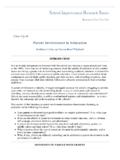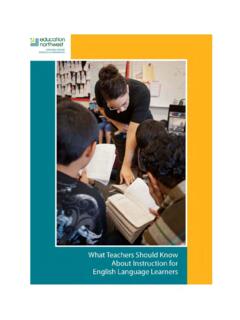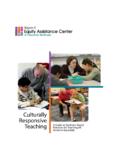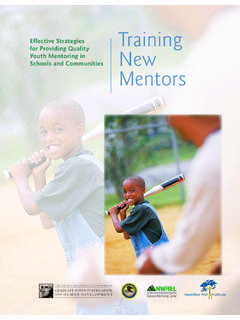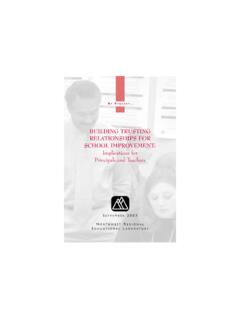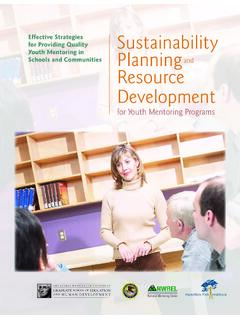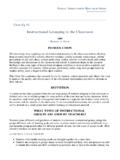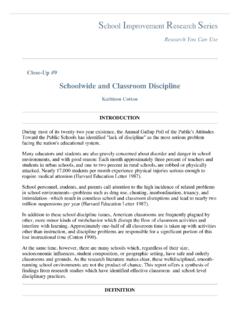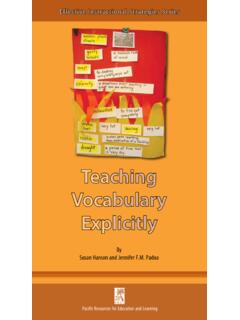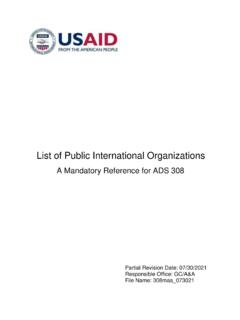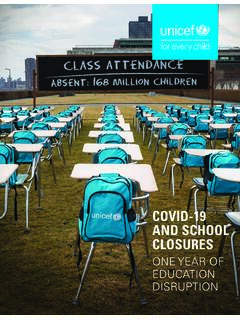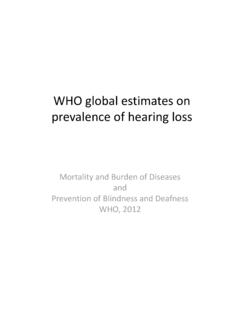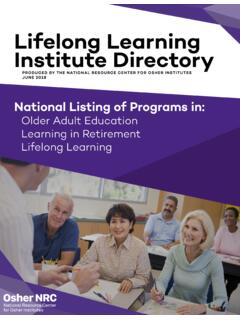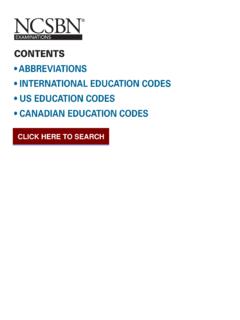Transcription of Culturally Responsive Teaching - Education Northwest
1 A Guide to Evidence-Based Practices for Teaching All Students EquitablyCulturally Responsive TeachingAbout the Region X Equity Assistance CenterThe Region X Equity Assistance Center (EAC) at Education Northwest helps schools and their communities incorporate educational equity into policies, procedures, and classroom practices to ensure that all students receive what they need to succeed academically. Our principal responsibilities are to provide and support planning, implementation, and sustainability for equity initiatives at the request of school boards and other responsible governmental agencies.
2 We work with our stakeholders to increase family and community engagement, improve student academic performance, and strengthen student engagement and school culture. We also provide assistance with Culturally Responsive Teaching , school safety, and compliance with the requirements of the federal Dear Colleague one of 10 centers funded by the Department of Education , we provide training and technical assistance to K 12 public schools within Region X at no cost or through a cost-share arrangement. Region X consists of Alaska, Hawaii, Idaho, Oregon, Washington, Territory of American Samoa, Commonwealth of the Northern Mariana Islands, Territory of Guam, Federated States of Micronesia (Chuuk, Kosrae, Pohnpei, Yap), Republic of the Marshall Islands, and Republic of Palau.
3 For more information or to request assistance, go to: ContactDr. Yvonne Ryans, Director, Region X Equity Assistance Center at Education Northwest 101 Main Street, Suite 500, Portland, Oregon 97204 Phone: (toll free: ) ProhibitedNo person in the United States shall, on the grounds of race, national origin, sex, or disability, be excluded from participation in, be denied the benefits of, or be subjected to discrimination under any program or activity receiving federal financial assistance, or be so treated on the basis of sex under most Education programs or activities receiving federal financial This PublicationThis publication is based on work supported wholly or in part by grant number S004D60006 and S004D990005 from the Department of Education .
4 The content of this document does not necessarily reflect the views of the department or any other agency of the United States government. Permission is hereby granted to reproduce this publication in whole or in part with the acknowledgment of the Region X Equity Assistance Center at Education Northwest as the source. at Education NorthwestEquity Assistance Center Region XMarch 2016 Basha KrasnoffRegion X Equity Assistance Center Education NorthwestA Guide to Evidence-Based Practices for Teaching All Students EquitablyCulturally Responsive TeachingContentsIntroduction.
5 1 Preparing Teachers to Be Culturally Responsive ..2 Effective Teaching is Culturally Responsive ..3 Teacher Expectations and Student Achievement ..4 Teacher Skills and Student Success ..8 Teacher Caring and Community Building ..9 Teachers Cultivating Cross-Cultural Communication ..10 Considering Cultural Diversity when Designing Instruction ..12 Teachers Recognizing Key Dimensions of Cultural Learning Diversity ..14 Teachers Creating an Equitable Classroom Climate ..16 Conclusion ..18 Limitations ..20 Appendix A: Educational Equity ..21 Appendix B: Considerations Beyond the Classroom.
6 23 References ..251 Culturally Responsive TeachingIntroductionStudents in the United States and its territories come from a large and increasing number of racially, ethnically, Culturally , and linguistically diverse families: diverse students made up 48 percent of the population in 2011, up from 39 percent in 2001. Teachers and school leaders, for the most part, do not reflect that diversity ( Department of Education Equity and Excellence Commission, 2013). In 2012, 84 percent of full-time public school teachers were White, 7 percent were Black, 7 percent were Hispanic, and fewer than 2 percent were Asian or pacific Islander (Aud et al.)
7 , 2013).The contrast in the demographic composition of educators and their students is cause for concern because research shows that students race, ethnicity, and cultural background significantly influence their achievement. (Harry & Klingner, 2006; Orosco & Klingner, 2010; Skiba et al., 2011). There is extensive evidence from achievement test scores, grade promotion rates, graduation rates, and other common indicators of school success that students from Culturally and linguistically diverse backgrounds experience poorer educational outcomes than their peers (Bennett et al.
8 , 2004; Conchas & Noguera, 2004; Sanders, 2000). Additional factors such as poverty and inadequate training or professional development opportunities for teachers compound this negative impact, as do systemic issues like biased assessment practices and institutional racism. According to Scott (2000), if the essential intention of Education is to positively impact students lives by equipping them with critical knowledge and skills through Culturally relevant, expert practice, then disparities in curriculum and instruction require that school districts shift their priorities and policies.
9 Scott suggests that districts: Require each teacher to obtain proper certification, training, and professional development Increase teacher motivation to recognize diverse learners strengths, as well as their needs Decrease dependence on packaged instructional materials and increase implementation of strategies and techniques targeted to the needs of specific student groups Integrate the use of technology into instructional practice to bridge the generational divide Recruit and retain high-quality teachers for schools in rural and remote areasAddressing the unique needs of students from diverse backgrounds is one of the major challenges facing public Education today because many teachers are inadequately prepared with the relevant
10 Content knowledge, experience, and training (Au, 2009; Cummins, 2007). Inadequate preparation can create a cultural gap between teachers and students (Gay, 2010; Ladson-Billings, 2009) that limits the ability of educators to choose effective instructional practices and curricular materials. Research on curriculum and instructional practices has primarily focused on White middle-class students, while virtually ignoring the cultural and linguistic characteristics of diverse learners (Orosco, 2010; Orosco & O Connor, 2011). A mandate for change requires that racially, ethnically, Culturally , and linguistically diverse students have the opportunity to meet their learning challenges with the strength and relevance found in their own cultural frame of reference.

